Beneficial Insects
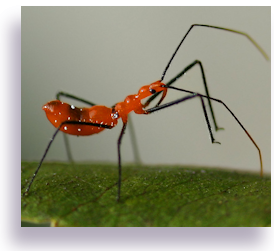 There are many insect pests that like to wage war against our beloved brugmansia, or angel trumpets. But there are many insects that will help you in your war against the insects. These include assassin bugs, dragonflies, honeybees, hoverflies, lacewings, ladybugs, soldierbugs (be careful, soldierbugs look very similar to stinkbugs, but are good) parasitic wasps, (or braconid wasps),, and praying mantis.
There are many insect pests that like to wage war against our beloved brugmansia, or angel trumpets. But there are many insects that will help you in your war against the insects. These include assassin bugs, dragonflies, honeybees, hoverflies, lacewings, ladybugs, soldierbugs (be careful, soldierbugs look very similar to stinkbugs, but are good) parasitic wasps, (or braconid wasps),, and praying mantis.
It is good to use beneficial insects whenever possible, to fight other insects. This keeps down toxic chemcial use, (and costs) to you as a gardener, and is less harmful to the environment. Becoming familiar with what beneficial insects look like will help you to protect them, and help them breed by supplying them with living plants they need.
Learning the lifecycles of these good bugs is also important. You will be able to know by sight, the different larval/pupae stages that some insects go through before reaching adulthood. This also, keeps you from harming important insects, no matter what stage in their brief lives they are at.
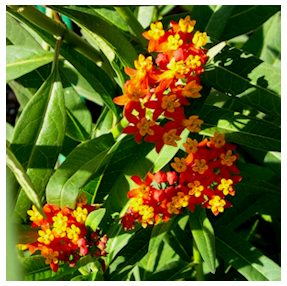 Controlling many insect pests can be as easy as planting out beds of Asclepias. Asclepias make great attractors to ladybugs. After your beds are established and the plants are blooming, in come the asclepias bugs. These black and red bugs are targeted by ladybugs and their offspring. Keeping the asclepias plants growing creates a foodchain of sorts. The plant first supports the asclepias bug, which in turn draws in the ladybugs, whose young eat the junior asclepias bugs. After having asclepias plants in my garden for a year or so, I have found ladybugs and ladybug lions on almost all of my other garden plants, so they spread out and remain a force to be reckoned with. I hear many gardeners complain they buy ladybugs but then they leave their gardens. Not if you have asclepias! Where I live (zone 10A)my established beds of asclepias have kept ladybugs in all of my gardens year round. And Ladybugs eat aphids, (sometimes found on asclepias too) mealybugs, and many other soft bodied pest insects.
Controlling many insect pests can be as easy as planting out beds of Asclepias. Asclepias make great attractors to ladybugs. After your beds are established and the plants are blooming, in come the asclepias bugs. These black and red bugs are targeted by ladybugs and their offspring. Keeping the asclepias plants growing creates a foodchain of sorts. The plant first supports the asclepias bug, which in turn draws in the ladybugs, whose young eat the junior asclepias bugs. After having asclepias plants in my garden for a year or so, I have found ladybugs and ladybug lions on almost all of my other garden plants, so they spread out and remain a force to be reckoned with. I hear many gardeners complain they buy ladybugs but then they leave their gardens. Not if you have asclepias! Where I live (zone 10A)my established beds of asclepias have kept ladybugs in all of my gardens year round. And Ladybugs eat aphids, (sometimes found on asclepias too) mealybugs, and many other soft bodied pest insects.
Another great factor in planting out asclepias plants, is they are the larval food of Monarch and Queen butterflies. And all sorts of butterflies drink nectar from the lovely flowers.
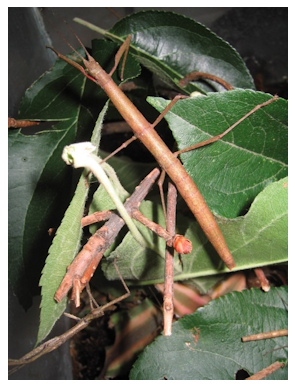 Walking Stick insects are also beneficial, preying on other pest insects that can and do invade your garden. Down here in South Florida, we have many species of them. A shy and solitary insect, they are hard to see, but if you have a large enough garden space with some undisturbed, taller plantings they will be attracted in and keep residence. Do not harm them if seen.
Walking Stick insects are also beneficial, preying on other pest insects that can and do invade your garden. Down here in South Florida, we have many species of them. A shy and solitary insect, they are hard to see, but if you have a large enough garden space with some undisturbed, taller plantings they will be attracted in and keep residence. Do not harm them if seen.
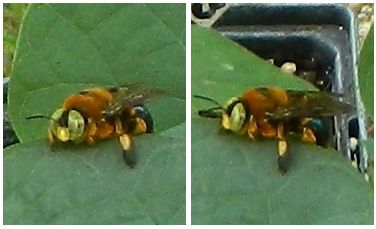 Placing out a small, undisturbed pond somewhere in the landscape will also help attract beneficial insects. To stop mosquitoes from breeding in it, add guppy fish. They are tropicals, and if you have a freezing winter, add a heater to it or remove fish come frosts and keep indoors until threat of last frost is over. But they will eat every mosquito larvae. And the pond will draw in dragonflies, frogs, toads, and other insects that eat the bad ones.
Placing out a small, undisturbed pond somewhere in the landscape will also help attract beneficial insects. To stop mosquitoes from breeding in it, add guppy fish. They are tropicals, and if you have a freezing winter, add a heater to it or remove fish come frosts and keep indoors until threat of last frost is over. But they will eat every mosquito larvae. And the pond will draw in dragonflies, frogs, toads, and other insects that eat the bad ones.
Plants beneficials need
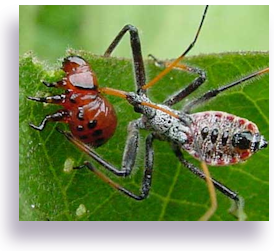 Make sure to cultivate plants that attract them to your garden. Many are nectar feeders, others may like to lay their eggs on a particular species of plant. Most all are herbs and medicinal herbs, so you could benefit from growing them for you and your family too.
Make sure to cultivate plants that attract them to your garden. Many are nectar feeders, others may like to lay their eggs on a particular species of plant. Most all are herbs and medicinal herbs, so you could benefit from growing them for you and your family too.
Chrysanthemum, Fennel, Mustard, Yarrow, Wormweed and Basil are a few plants that attract various beneficial insects. Other plants that will draw them in include daisies, mint, onion, garlic, dillweed, carrots, chives, marjoram, oregano, chamomile, marigold, coreopsis, tansy, sunflowers, goldenrod, caraway, anise, dandelion, clovers, buckwheat, loveage, bee balm, hyssop, lamb's quarters, catnip, lavendar, thyme and angelica.
Tags: tag, beneficial insects, assasin bug, soldier bug, lady bug, praying mantis, honeybee, lacewing, parasitic wasp, hoverflies,



